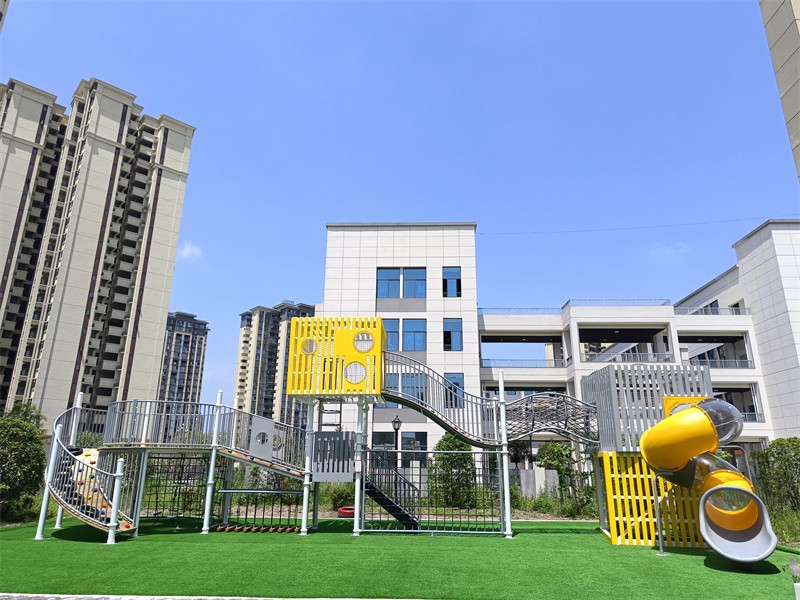In modern society, children's environments are increasingly diverse and enriching, and outdoor activities are crucial for their healthy physical and mental development. Among the many outdoor activity facilities, non-powered play equipment is increasingly becoming a popular choice for parents and children. So, what makes non-powered play equipment stand out among children's outdoor activities?
1. High safety, reassuring parents
Safety is a primary consideration for children's play equipment. Non-powered play equipment, which relies on no external power sources like electricity or fuel, fundamentally eliminates serious safety hazards such as fire and electric shock caused by power system failures. Its design fully considers children's physical characteristics and behavioral habits, featuring rounded corners, soft protective materials, and a sturdy structure. For example, a slide's smooth surface and a gradual slope ensure children's rapid descent while preventing collisions and injuries. Climbing frames are strategically spaced and equipped with safety handrails and nets to effectively prevent children from falling. These meticulous safety features ensure parents can rest assured while their children play, without the constant worry of accidents.
2. Promotes Physical Development and Strengthens Physical Fitness
Children are in a critical period of rapid physical development. Outdoor activities are crucial for developing their coordination, balance, and muscle strength. Non-powered play equipment provides children with a rich and diverse range of exercise experiences, comprehensively strengthening their physical fitness. Swinging on a swing, for example, requires children to constantly adjust their body posture and center of gravity to maintain balance. This not only develops their sense of balance but also strengthens their upper limbs, as the arms are required to exert force when pushing the swing. Climbing frames require children to use their hands and feet, climbing and scrambling, effectively developing their coordination and muscle strength. Furthermore, the height and difficulty of the climbing surfaces can inspire children's courage and adventurous spirit. Trampolines allow children to develop their jumping ability, improve their flexibility and agility, and promote bone and muscle development.

3. Stimulates Creativity and Imagination
The openness and diversity of non-powered play equipment provide children with ample room for creativity. Unlike some amusement facilities with fixed functions and a single gameplay, non-powered play equipment often has no fixed usage. Children can create their own ways of playing based on their interests and imagination. In the sandpit, children can use sand to build castles, hills, and tunnels in various shapes, giving full play to their imaginations. Children can imagine a simple tire swing as a pirate ship sailing the sea or an airplane soaring through the sky, creating fantastical scenes as they play. This free creative process not only provides children with endless fun but also stimulates their innovative thinking, fostering their creativity and imagination, laying a solid foundation for their future studies and life.
Fourth, Cultivating Social Skills
Childhood is a crucial period for developing social skills. Non-powered play equipment often requires children to participate together, providing opportunities for interaction and communication with their peers. On a multi-person swing, children need to cooperate and push together to swing higher and farther. In this process, they learn to communicate, collaborate, and share. Around the climbing frame, children encourage and help each other, working together to tackle increasingly challenging challenges. Through communication and collaboration, they make new friends, learn how to get along with others, and strengthen their sense of teamwork and social skills. This naturally occurring social interaction helps children understand and master social rules more effectively than simple lecturing, building strong interpersonal relationships and improving their social adaptability.
5. Connecting with Nature and Enjoying the Outdoors
With the acceleration of urbanization, children's opportunities to connect with nature are decreasing. Non-powered play equipment is often located in natural environments such as outdoor parks and green spaces, allowing children to connect with nature while playing, experiencing the sun, air, and the changing seasons. They can run and play on the grass, climb through the trees, listen to the birdsong, and observe the growth of flowers and trees. This close contact with nature not only allows children to relax and relieve the stress of study and life, but also cultivates their love for nature and a sense of conservation. Playing in a natural environment allows children to experience the joys of the outdoors more authentically, enriching their life experiences, broadening their horizons, and promoting their physical and mental health.
Non-powered play equipment, with its unique advantages, plays a vital role in children's outdoor activities. It not only provides a safe and engaging play environment, but also fosters their physical, intellectual, emotional, and social development. Allowing children to fully enjoy the outdoors on non-powered play equipment is one of the best ways to ensure a healthy and happy childhood. Parents and educators alike should prioritize the value of non-powered play equipment in children's development and create more opportunities for children to interact with and use it.
+86-13566236059
#16 Chuangqiang Road, Light industrial area, Lucheng district, Wenzhou city, Zhejiang Province, China.
+86-577-85951908
+86-577-86457291
